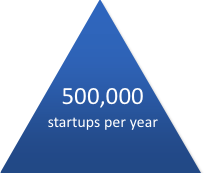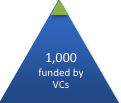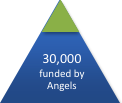Far more and far fewer than most people think…
The reality of funding is that very few startups receive any funding from Angel investors or venture capitalists. There is a lot of research about investments into early-stage companies (at least in the U.S.) and the numbers are well documented.
Each year, over 500,000 companies are started in the United States.
(Source: Kauffman Foundation and U.S. Small Business Administration)

Of these, venture capitalists invest in fewer than 1,000 per year, plus Angels and Angel Group in roughly another 30,000 startups.
(Sources: PricewaterhouseCoopers Money Tree Survey and Angel Resource Institute and Silicon Valley Bank HALO Report)


What these numbers tell us is that, at most, only six percent of all startups receive any funding from these sources. The deeper reality is that the actual numbers are probably even lower.
Why lower? Most “venture-backed” startups have previously been funded by Angels, and most Angel-backed startups receive investments from multiple Angel groups, all of which causes some double-counting in these statistics. Thus, the true odds of any startup being funded by Angels or VCs is likely closer to three percent than six.
This is certainly not how it seems from reading the newspaper or startup blogs. Or from listening to the frenzy of entrepreneurs, who expect that funding is available for every entrepreneur who asks for it.
So don’t start your companies with an expectation that such funding will follow. The odds are against you.
Instead, go back to the first statistic, noting that the vast majority of the 500,000 startups manage to get up and running without any Angel or venture capital funding, using savings, friends and family, and little else in terms of funding.
That big number includes all the corner stores, landscaping companies, dry cleaners, supermarkets, etc., plus the myriad consultants, accountants, and other independent contractors who incorporate their businesses. Such companies allow the owner and employees to earn a living but usually do not make a fortune.
Those companies are the majority, not the exception. The exceptions are the startups that are funded by Angels and VCs. The exceptions turn $1 million into $100 million. That is the reason why companies that raise money are covered by the newspapers, magazines, and blogs. Those deals are rare and, thus, news!
Beyond the U.S.
These statistics are limited to U.S. startups. Worldwide, tens of millions of companies are started each year, and far fewer than six percent are funded by outside investors. The reality is likely under one percent.
In general, the farther you are from a major world city, the less likely your odds of finding any funding.
Within the U.S.
Even within the U.S., the reporting shows that funding is not spread evenly across the whole country. In most years, ten times more investments take place within California than any other state or even within whole regions of the country.
Startup investing is focused on specific cities within the U.S., including: San Francisco (and the whole Bay Area), New York City, Boston, Seattle, Boulder/Denver, and Austin. Even major cities like Chicago, Dallas, and Los Angeles often see fewer investments in both numbers and dollars than far smaller cities like Seattle, Boulder, and Austin.
These select cities are entrepreneurial “hubs,” with thriving ecosystems of entrepreneurs, investors, and other support structures. Many cities worldwide strive to replicate their success, but, over the past few decades, this list has grown very little.











